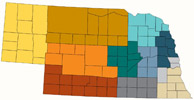Extension, Cooperative

Nebraska Cooperative Extension: Faculty and Staff Publications
Document Type
Article
Date of this Version
8-18-2022
Citation
J Evol Biol. 2022;35:1319–1334. DOI: 10.1111/jeb.14079
Abstract
Mismatches between parental genomes in selfish elements are frequently hypothesized to underlie hybrid dysfunction and drive speciation. However, because the genetic basis of most hybrid incompatibilities is unknown, testing the contribution of selfish elements to reproductive isolation is difficult. Here, we evaluated the role of transposable elements (TEs) in hybrid incompatibilities between Drosophila virilis and D. lummei by experimentally comparing hybrid incompatibility in a cross where active TEs are present in D. virilis (TE+) and absent in D. lummei, to a cross where these TEs are absent from both D. virilis (TE−) and D. lummei genotypes. Using genomic data, we confirmed copy number differences in TEs between the D. virilis (TE+) strain and both the D. virilis (TE−) strain and D. lummei. We observed F1 postzygotic reproductive isolation exclusively in the interspecific cross involving TE+ D. virilis but not in crosses involving TE− D. virilis. This mirrors intraspecies dysgenesis where atrophied testes only occur when TE+ D. virilis is the paternal parent. A series of backcross experiments, that accounted for alternative models of hybrid incompatibility, showed that both F1 hybrid incompatibility and intrastrain dysgenesis are consistent with the action of TEs rather than genic interactions. Thus, our data suggest that this TE mechanism manifests as two different incompatibility phenotypes. A further Y-autosome interaction contributes to additional, sex-specific, inviability in one direction of this cross-combination. These experiments demonstrate that TEs that cause intraspecies dysgenesis can increase reproductive isolation between closely related lineages, thereby adding to the processes that consolidate speciation.
Included in
Agricultural and Resource Economics Commons, Agricultural Education Commons, Food Science Commons, Rural Sociology Commons


Comments
Open access.